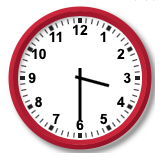AndrewN
A bell tower with an analog clock—one that displays the numbers 1 to 12 on its face—has just reached the top of the hour. If the bell chimes to match the hour (e.g., 5 chimes at 5.00am or 5.00pm), then how many times does the bell chime?
(1) Half an hour ago, the measure of the angle between the minute hand and the hour hand was 75 degrees.
(2) At present, the hour hand is pointing to a number that has an odd number of positive factors.
Hello, everyone. I wanted to create a question that combined geometry with number properties and factorization in a way that was both fun and GMAT™-like. (My self-made Quant questions are usually PS questions.) All we have to do with this question, essentially, is answer what time the clock face shows, and we even know that it is
the top of the hour, so it can be noon, 1.00, 8:00, and so on, but we do not need to worry about the minute hand. When I work on DS questions, I like to glance at the two statements and select the easier point of entry to narrow the answer pool. To my eye, Statement (2) looks much easier than Statement (1), which mentions a
different time and an angle measurement. So, how about we look at Statement (2)?
If
the hour hand is pointing to a number that has an odd number of positive factors, then we should be thinking of
perfect squares—all other positive integers will have an even number of positive factors. The perfect squares between 1 and 12 are 1, 4, and 9. Since we have no more information to lean on,
Statement (2) is NOT sufficient on its own.
Statement (1) tells us that
half an hour ago, the measure of the angle between the minute hand and the hour hand was 75 degrees. To qualify the degree measurement, we need to have a clear idea of an analog clock face. (All of the following images are taken from a clock face generator on the site
Helping with Math.)
Attachment:
 Screen Shot 2022-02-25 at 11.51.50.png [ 27.07 KiB | Viewed 1146 times ]
Screen Shot 2022-02-25 at 11.51.50.png [ 27.07 KiB | Viewed 1146 times ]
We can appreciate that since there are 360 degrees in a circle, and there are 12 equally spaced numbers on the face, there will be
\(\frac{360}{12}\)
or 30 degrees between each of those numbers or hours. Thus, we are looking for a time at which the minute and hour hands would be two and a half "spaces" apart. We could try, say, 9.30, just to get our feet wet:
Attachment:
 Screen Shot 2022-02-25 at 11.59.20.png [ 27.27 KiB | Viewed 1142 times ]
Screen Shot 2022-02-25 at 11.59.20.png [ 27.27 KiB | Viewed 1142 times ]
Clearly, the time at present CANNOT be 10.00, since the angle between the minute and hour hands at 9.30 would have been 105 degrees (30-30-30-15). We can either test different values, or we can appreciate that
since the minute hand will be fixed at 6 and the hour hand will be halfway between numbers, only the position of the hour hand will change for each hour, and it will do so by exactly 30 degrees. Thus, using our above benchmark, we can deduce that going back even one more hour will produce the desired 75 degrees between minute and hour hands:
Attachment:
 Screen Shot 2022-02-25 at 12.02.08.png [ 27.29 KiB | Viewed 1131 times ]
Screen Shot 2022-02-25 at 12.02.08.png [ 27.29 KiB | Viewed 1131 times ]
8:30 was a valid time, so it could, at present, by 9:00, and there would be 9 chimes. All we have to do is determine whether 9.00 is the only valid time. Of course, since a clock face has a vertical axis of symmetry, we can appreciate that, half an hour ago, 3:30 would have been just as valid a time as 8:30, and it could, at present, be 4:00, with 4 chimes tolling.
Attachment:
 Screen Shot 2022-02-25 at 12.11.28.png [ 27.38 KiB | Viewed 1109 times ]
Screen Shot 2022-02-25 at 12.11.28.png [ 27.38 KiB | Viewed 1109 times ]
With two valid answers, we can say with confidence that
Statement (1) is NOT sufficient on its own.
Combined, the two statements get us no closer to determining the time, since both 4:00 and 9:00 conform to the two statements. Therefore,
the answer must be (E).
I hope you had fun with this one. There are a few concepts that I could see popping up on the GMAT™. As always, good luck with your studies (and watch those assumptions on DS questions).
- Andrew

 75%
(hard)
75%
(hard)
 66%
(02:27)
wrong
66%
(02:27)
wrong  based on 38
sessions
based on 38
sessions